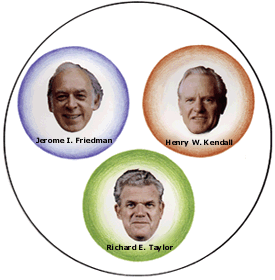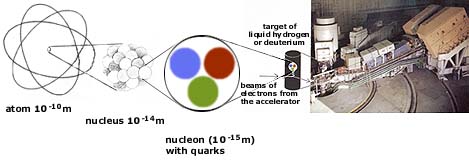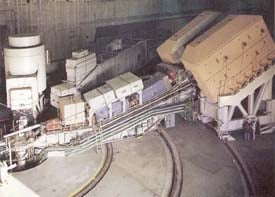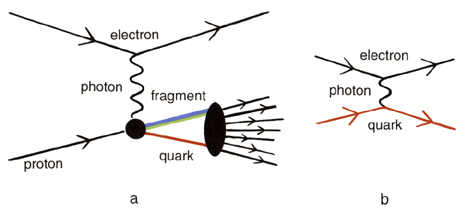Illustrated presentation
The Nobel Prize in Physics 1990
The Royal Swedish Academy of Sciences has awarded this year’s Nobel Prize in Physics jointly to
Jerome I. Friedman and Henry W. Kendall
Massachusetts Institute of Technology (MIT), Cambridge, USA
and
Richard E. Taylor
Stanford Linear Accelerator Center (SLAC), CA, USA
for their pioneering investigations concerning deep inelastic scattering of electrons on protons and bound neutrons, which have been of essential importance for the development of the quark model in particle physics

Breakthrough in our understanding of the inner structure of matter
J.I. Friedman, H.W. Kendall and R.E. Taylor were key persons in the research team which discovered an inner structure in the protons and neutrons of the atomic nucleus. Their series of investigation constituted the now so well-known SLAC-MIT experiment.
Knowledge of the inner structure of the atom has increased successively. Between 1910 and 1940, the nucleus of the atom and its nucleons (protons and neutrons) were discovered. During the 1950s, a large number of particles, termed hadrons, were discovered, whose properties resembled those of the nucleons. They behaved like members of different families. To be able to describe these families theoretically, three building blocks, quarks, were introduced. Now all hadrons then known could be built up of these quarks and their antiparticles. This allowed great conceptual simplification, and the quark concept was immediately taken seriously. Quarks were sought both in nature, e.g. in sea water, meteorites and cosmic radiation, and in experiments using high-energy accelerators. No quarks were found. After a time, the most popular explanation of the absence of the quarks was that they were only “mathematical quantities” in the equations of physics. Not until the SLAC-MIT experiment of 1968 were the first traces of quarks seen.
The discovery was made when protons and neutrons were illuminated by beams from a giant “electron microscope” – the two-mile-long SLAC accelerator. An inner structure was then seen and interpreted to mean that quarks represent the fundamental building blocks of protons and neutrons. Signs were also seen of the electrically neutral “glue”, gluons, that binds the quarks together. All the earth’s matter, including our human bodies, consists to more than 99% of quarks and their associated gluons. The little that remains, is electrons.

The history of particles
| 1911 | Ernest Rutherford publishes his famous paper The scattering of alpha and beta particles by matter and the structure of atoms, in which measurements made by among others Hans Geiger and Ernest Marsden in 1909 were analysed. Rutherford explains the results of such measurements by the atom having all its mass concentrated to a nucleus of less than 10-14 m. This discovery marks the birth of nuclear physics. |
| 1919 | Ernest Rutherford demonstrates free protons by bombarding nitrogen with alpha particles. He concludes that nuclei have an inner structure. |
| 1932 | James Chadwick discovers the neutron and Werner Heisenberg proposes that the nucleus consists of protons and neutrons, together termed nucleons. |
| 1933- 1934 |
Otto Stern and his co-workers discovers that the proton and the neutron have unexpectedly large (anomalous) magnetic moments. This is interpreted to mean that nucleons are not point-like, but occupy a certain volume, and can thus possess an inner structure. |
| 1935 | A first model of how nucleons can form stable nuclei (strong interaction) is presented by Hideki Yukawa. |
| 1950s | It is discovered that the nucleon (like the atom and the nucleus) can be excited to higher energy levels. A large number of new particles, hadrons, related to the nucleon, are discovered. Robert Hofstadter and his co-workers study the structure of protons and neutrons at the electron accelerator at Stanford. Using electron energies of up to 1 GeV (1 GeV is 109 eV) they measure how charge and magnetism are distributed within the nucleons. It is found that the distributions give a picture of the nucleons as “soft spheres”. |
| 1964 | Murray Gell-Mann and Georg Zweig propose a model for the hadrons which, among other things, can theoretically describe the magnetic properties of the nucleon. The model requires three new elementary particles, which Gell-Mann calls quarks. But it is by no means clear that the quarks are true particles – they are perhaps only theoretical tools without experimental reality. Be that as it may, no free quarks are discovered. |
| 1967 | The SLAC-MIT experiment starts at the new electron accelerator in Stanford. Jerome I. Friedman, Henry W. Kendall, Richard E. Taylor and their co-workers obtain in 1968 the first indications that the nucleons have an inner structure with point-like scattering centres. These are later interpreted as being quarks. |
| Since 1968 |
Intensive research into the inner structure of the nucleons starts all over the world, and is still continuing. |
The SLAC-MIT experiment
With the new SLAC electron accelerator, the intention was to continue and, hopefully, improve of Hofstadter’s investigations of the charge structure of the proton. Following initial experiments in which the research team studied “elastic” collisions without finding anything exciting, the part of the team which included this year’s Nobel Laureates started to investigate “inelastic collisions”. In this, the SLAC-MIT experiment, the scattering angle and energy loss of the electron after the collision were observed: these together give a measure of whether the collision really is inelastic, and also of the degree of inelasticity. By selecting electrons, which scattered at increasingly large angles and with increasing energy losses (corresponding to photons of decreasing wavelengths), the research team analysed deeper and deeper layers of the proton. Earlier investigations of the proton at low energies had shown that this ought to be “soft” with a relatively even internal distribution of its electrical charge. This year’s Laureates therefore had reason to believe there would be a decline in the probability of photon absorption (low number of events). But they found instead a high probability level (many events), i.e. there seemed to be something small and “hard” inside the proton.
Thus the new investigations gave the surprising result that the electrical charge within the proton is concentrated to smaller components of negligible size.
This unexpected discovery by the 1990 Laureates was noted immediately by certain skilled theoreticians, chiefly R.P. Feynman and J.D. Bjorken. The result was first interpreted within the framework of what is termed the parton model, which, however, soon came to be identified with the quark model. Very thorough analysis of the experimental results also gave the first hint of the existence of the neutral “glue particles”, later to be called gluons.

Large magnetic spectrometers were designed and built to achieve high quality in the measurements. Taylor directed the work on the mechanics and the magnets while Friedman and Kendall designed the detectors that were to record the scattered electrons after collisions in a target of liquid hydrogen or deuterium. The spectrometer arms are turned on rails around the target to select different angles.
The deep inelastic collision
In the collision between an electron from the accelerator and a proton in the target, the particles affect each other through exchange of a light quantum, a photon. The wavelength of this photon determines the resolution of the “electron microscope”. In this connection, scientists speak of “elastic” and “inelastic” collisions*. Inelastic collision between an electron and a proton is illustrated in figure a.
When the wavelength of the photon is long, it “sees” the charge of the whole proton (elastic or slightly inelastic collisions), but when the wavelength becomes sufficiently short, the photon “sees” primarily any charged small constituents within the proton (deep inelastic collisions). The performance of the new accelerator, 21 GeV, guaranteed that the electrons could emit short-wave photons, but a condition for the exchange of such photons was that there should be some small “hard” receiver within the protons.
The result of the experiment showed that when the photon wavelength is short, i.e. its momentum is great, the proton is generally smashed to pieces and a number of particles are produced (figure a). Thus there are suitable receivers! That the event in figure a looks so complex is partly because of the complicated structure of the proton and partly because its quarks must be converted into ordinary particles. The deep inelastic collision in figure a is basically a simple elastic collision between the electron and a quark (figure b).
*One way to understand these terms is to make a comparison with the collision between billiard balls. An elastic collision means that the collision does not damage either of the balls, while an inelastic collision damages one or both balls permanently.

Further reading
Information on the 1990 Nobel Prize in Physics (press release), The Royal Swedish Academy of Sciences.
Close, Frank: The Cosmic Onion. Heinemann Educational Books Ltd 1985, Chap. 6.
Kendall, Henry W. & Panofsky, Wolfgang: The structure of the proton and the neutron. Scientific American, June 1971, Vol 224, No 6, page 60.
Lederman, Leon M. & Schramm, David N.: Experimental verification of quarks. From Quarks to the Cosmos. Scientific American Library 1989.
Based on materials from the 1990 Nobel Poster for Physics.
Credits and references for the 1990 Physics Nobel Poster
Editors: Solgerd Björn-Rasmussen and Margareta Wiberg Roland, Information Department, The Royal Swedish Academy of Sciences
Authors: Professor Göran Jarlskog, Department of Physics, Lund University, Sölvegatan 14, S-223 62 Lund, Sweden and Professor Cecilia Jarlskog, Department of Physics, Stockholm University, Vanadisvägen 9, S-113 46 Stockholm, Sweden
Illustrator: Karin Feltzin, Stockholm
Printed by Tryckindustri 1990
Copyright © The Royal Swedish Academy of Sciences, Information Department, Box 50005, S-104 05 Stockholm, Sweden, Tel. +46-8-673 95 00, Fax +46-8-15 56 70, Email: info@kva.se.
Web adapted version: Nobelprize.org
Every effort has been made by the publisher to credit organizations and individuals with regard to the supply of photographs and illustrations. The publishers apologize for any omissions which will be corrected in future editions.
Nobel Prizes and laureates
Six prizes were awarded for achievements that have conferred the greatest benefit to humankind. The 12 laureates' work and discoveries range from proteins' structures and machine learning to fighting for a world free of nuclear weapons.
See them all presented here.
